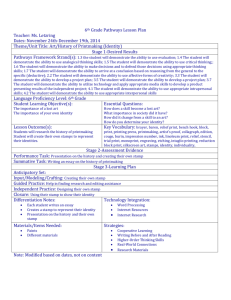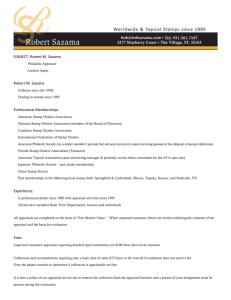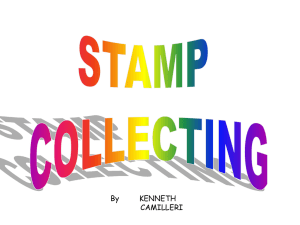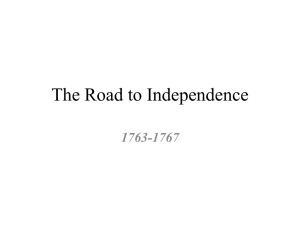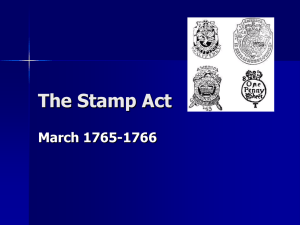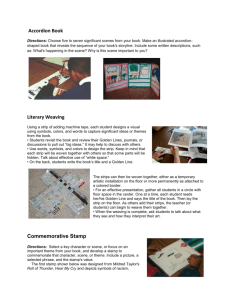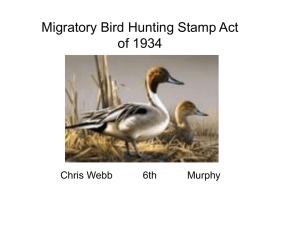Frank GAYLORD v. UNITED STATES United States Court of
advertisement
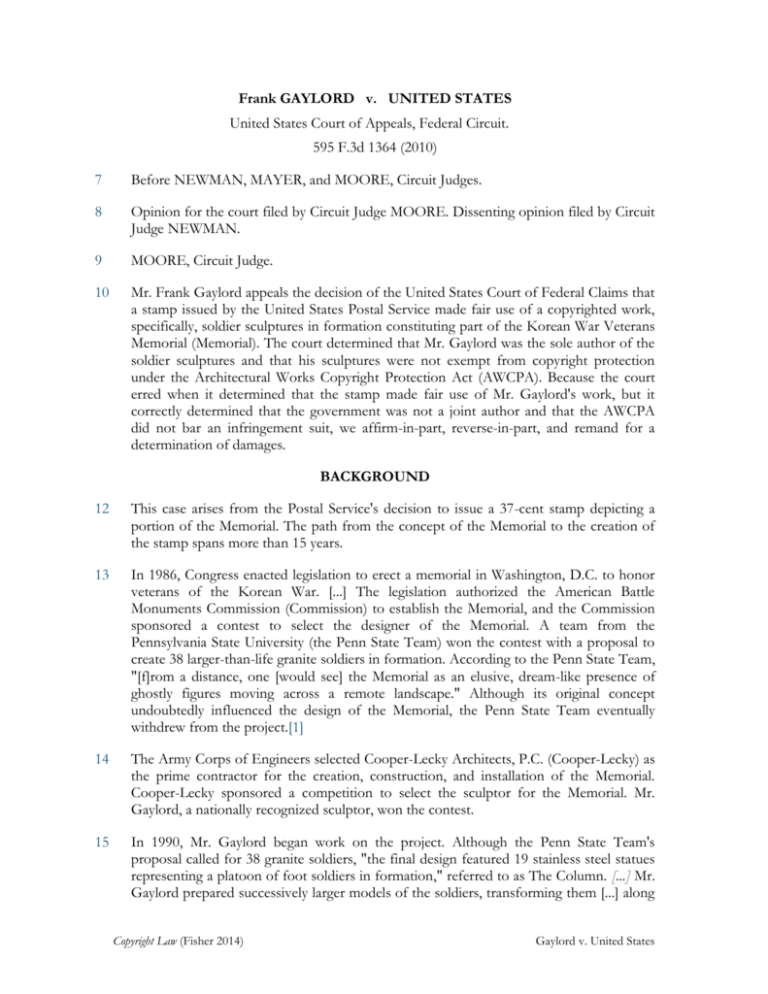
Frank GAYLORD v. UNITED STATES United States Court of Appeals, Federal Circuit. 595 F.3d 1364 (2010) 7 Before NEWMAN, MAYER, and MOORE, Circuit Judges. 8 Opinion for the court filed by Circuit Judge MOORE. Dissenting opinion filed by Circuit Judge NEWMAN. 9 MOORE, Circuit Judge. 10 Mr. Frank Gaylord appeals the decision of the United States Court of Federal Claims that a stamp issued by the United States Postal Service made fair use of a copyrighted work, specifically, soldier sculptures in formation constituting part of the Korean War Veterans Memorial (Memorial). The court determined that Mr. Gaylord was the sole author of the soldier sculptures and that his sculptures were not exempt from copyright protection under the Architectural Works Copyright Protection Act (AWCPA). Because the court erred when it determined that the stamp made fair use of Mr. Gaylord's work, but it correctly determined that the government was not a joint author and that the AWCPA did not bar an infringement suit, we affirm-in-part, reverse-in-part, and remand for a determination of damages. BACKGROUND 12 This case arises from the Postal Service's decision to issue a 37-cent stamp depicting a portion of the Memorial. The path from the concept of the Memorial to the creation of the stamp spans more than 15 years. 13 In 1986, Congress enacted legislation to erect a memorial in Washington, D.C. to honor veterans of the Korean War. [...] The legislation authorized the American Battle Monuments Commission (Commission) to establish the Memorial, and the Commission sponsored a contest to select the designer of the Memorial. A team from the Pennsylvania State University (the Penn State Team) won the contest with a proposal to create 38 larger-than-life granite soldiers in formation. According to the Penn State Team, "[f]rom a distance, one [would see] the Memorial as an elusive, dream-like presence of ghostly figures moving across a remote landscape." Although its original concept undoubtedly influenced the design of the Memorial, the Penn State Team eventually withdrew from the project.[1] 14 The Army Corps of Engineers selected Cooper-Lecky Architects, P.C. (Cooper-Lecky) as the prime contractor for the creation, construction, and installation of the Memorial. Cooper-Lecky sponsored a competition to select the sculptor for the Memorial. Mr. Gaylord, a nationally recognized sculptor, won the contest. 15 In 1990, Mr. Gaylord began work on the project. Although the Penn State Team's proposal called for 38 granite soldiers, "the final design featured 19 stainless steel statues representing a platoon of foot soldiers in formation," referred to as The Column. [...] Mr. Gaylord prepared successively larger models of the soldiers, transforming them [...] along Copyright Law (Fisher 2014) Gaylord v. United States the way in response to critiques and suggestions by Cooper-Lecky, members of the Korean War Veterans Memorial Advisory Board (VAB), and the Commission on Fine Arts (CFA). Once Mr. Gaylord completed models for the soldiers, they were cast in stainless steel and installed at the site of the Memorial on the National Mall in Washington, D.C. At the suggestion of a member of the VAB, Mr. Gaylord staggered the statues, thereby creating the composition of The Column. Cooper-Lecky, the VAB, and the CFA all participated in incorporating The Column into the Memorial, which also includes landscaping, a mural, and granite plates representing the reflection of rice paddies at the soldiers' feet. A picture of The Column— taken on a sunny day—is below.[...] 17 Mr. Gaylord received five copyright registrations relating to the soldier sculptures from 1990 to 1995. Each certificate listed Mr. Gaylord as the sole author. The registrations include pictures of the clay models for the sculptures as they evolved over the years, and eventually, the sculptures themselves. For example, in his November 11, 1993 registration, he described the work as clay "statuettes—fully approved—19 soldiers—National Korean War Veterans Memorial." His August 12, 1994 registration concerned "19 7'-6" tall clay soldiers to be cast in stainless steel for the National Korean War Veterans Memorial on the mall in Washington, D.C." Shortly after the statues were installed, on May 1, 1995, Mr. Gaylord filed a certificate of copyright registration for the soldiers as they appeared before and after casting. This certificate included photographs of the soldiers as installed on the National Mall. 18 In 1995, shortly after the Memorial was dedicated, a photographer named John Alli took a photograph of the Memorial as a retirement gift for his father, a veteran of the Korean War. Mr. Alli visited the Memorial on five or six occasions, taking photographs at various times of year and day. One such visit occurred in January 1996 just after a snowstorm. Over the course [...] of about two hours on that cold winter morning, Mr. Alli took about 100 photographs of the Memorial, including photographs of individual soldiers, from various angles using different exposures and lighting conditions. Mr. Alli selected one of his photographs for his father's retirement gift. The photograph, titled "Real Life," is reproduced below. No one questions that Mr. Alli is entitled to his own copyright protection in his photograph as a derivative work.[...] 20 Mr. Alli decided to sell prints of the photograph. He therefore sought permission from the copyright owner of the underlying work, eventually locating Mr. Lecky of CooperLecky, who held himself out as the "outright" owner of the copyright. Mr. Alli agreed to pay a 10% royalty on sales of prints of his photographs to a licensing entity established by Mr. Lecky. Mr. Lecky did not notify Mr. Gaylord about the agreement with Mr. Alli.[2] 21 In 2002, the Postal Service decided to issue a 37-cent stamp commemorating the 50th anniversary of the armistice of the Korean War. The Postal Service selected Mr. Alli's photograph for the stamp and paid him $1500 for its use. Mr. Alli told the Postal Service that it would need the permission of the owner of the copyright of the underlying work and referred the Postal Service to Mr. Lecky. 22 The Postal Service issued the stamp, titled "Korean War Veterans Memorial." The stamp features Mr. Alli's photo and depicts 14 of the 19 soldier sculptures[...]. Copyright Law (Fisher 2014) Gaylord v. United States 24 [...] The Postal Service produced approximately 86.8 million stamps before retiring the stamp on March 31, 2005. The Postal Service acknowledged that it received over $17 million from the sale of nearly 48 million stamps. It was estimated that in 2003, the Postal Service generated $5.4 million from the sales of stamps to collectors who did not use the stamps to send mail. In addition, the Postal Service sold retail goods such as commemorative panels and framed art featuring images of the stamp. It did not seek or obtain Mr. Gaylord's permission to use the sculptures in the stamp or in any related retail goods. 25 Mr. Gaylord sued the government in the Court of Federal Claims on July 25, 2006, alleging infringement of his copyright. On June 16-20, 2008, the Court of Federal Claims conducted a trial, at which the government argued that the stamp made fair use of the work, excepting it from copyright liability. The government further argued that it had rights to the work as a joint author, which would provide it an unlimited license in the work. Finally, the government argued that the stamp fell under the exclusion from liability for copyright infringement for architectural works under the AWCPA. The Court of Federal Claims determined that Mr. Gaylord was the sole copyright owner of The Column and that The Column did not qualify as an architectural work under the AWCPA. [...] However, the Court of Federal Claims also determined that the government was not liable for copyright infringement because the government's use of The Column was fair use. [...] Mr. Gaylord appeals the court's decision as to fair use, and the government challenges the court's determinations of ownership and the inapplicability of the AWCPA. [...] DISCUSSION 27 We review the Court of Federal Claims' legal conclusions de novo and its factual findings for clear error. [...] Infringement requires two elements: "(1) ownership of a valid copyright, and (2) copying of constituent elements of the work that are original." [...] The government does not dispute the validity of the copyright or that the stamp copied original elements of The Column. This appeal concerns whether the government can establish fair use, ownership rights through a joint author, or an exemption to liability under the AWCPA. I. Fair Use 29 Fair use of a copyrighted work "for purposes such as criticism, comment, news reporting, teaching (including multiple copies for classroom use), scholarship, or research, is not an infringement of copyright." 17 U.S.C. § 107. "The fair use doctrine thus `permits [and requires] courts to avoid rigid application of the copyright statute when, on occasion, it would stifle the very creativity which the law is designed to foster.'" Campbell v. Acuff-Rose Music, Inc., 510 U.S. 569, 577[...] (1994) [...]. 30 Fair use is a mixed question of law and fact. [...] Because "the doctrine is an equitable rule of reason, no generally applicable definition is possible, and each case raising the question must be decided on its own facts." [...] Section 107 requires courts to consider four nonexclusive factors when evaluating fair use: Copyright Law (Fisher 2014) Gaylord v. United States 31 (1) the purpose and character of the use, including whether such use is of a commercial nature or is for nonprofit educational purposes; (2) the nature of the copyrighted work; (3) the amount and substantiality of the portion used in relation to the copyrighted work as a whole; and (4) the effect of the use upon the potential market for or value of the copyrighted work. 32 [...] Each factor is "to be explored, and the results weighed together, in light of the purposes of copyright." [...] A. Purpose and Character of the Infringing Use 34 When evaluating the purpose and character of the use, one must consider "whether the new work merely `supersede[s] the objects' of the original creation or instead adds something new, with a further purpose or different character, altering the first with new expression, meaning, or message; it asks, in other words, whether and to what extent the new work is `transformative.'" [...] Although "transformative use is not absolutely necessary for a finding of fair use, the goal of copyright, to promote science and the arts, is generally furthered by the creation of transformative works. Such works thus lie at the heart of the fair use doctrine's guarantee of breathing space within the confines of copyright." [...] 35 The Court of Federal Claims concluded that this factor weighed heavily in favor of fair use because the stamp was transformative. [...] The court determined that "while both the Stamp and `The Column' are intended to honor veterans of the Korean War, the Stamp is transformative, providing a different expressive character than `The Column.'" [...] It explained that Mr. Alli transformed the three-dimensional sculpture with his photograph by "creating [...] a surrealistic environment with snow and subdued lighting where the viewer is left unsure whether he is viewing a photograph of statues or actual human beings." [...] The court determined that the Postal Service further transformed The Column by "making it even grayer, creating a nearly monochromatic image. This adjustment enhanced the surrealistic expression ultimately seen in the Stamp by making it colder." [...] The Court of Federal Claims concluded that the stamp was "a transformative work, having a new and different character and expression than Mr. Gaylord's `The Column.'" [...] 36 We disagree. As a preliminary matter, we note that the inquiry must focus on the purpose and character of the stamp, rather than that of Mr. Alli's photograph. The stamp does not reflect any "further purpose" than The Column. [...] As the Court of Federal Claims found, both the stamp and The Column share a common purpose: to honor veterans of the Korean War. 37 Works that make fair use of copyrighted material often transform the purpose or character of the work by incorporating it into a larger commentary or criticism. For example, in Blanch v. Koons, an artist incorporated a copyrighted photograph of a woman's Copyright Law (Fisher 2014) Gaylord v. United States feet adorned with glittery Gucci sandals into a collage "commenting on the `commercial images ... in our consumer culture.'" [...] The court determined that this was fair use in part because the collage was transformative. [...] It reasoned that the collage and the photo had "sharply different" purposes and that the collage was intended to be a "commentary on the social and aesthetic consequences of mass media." [...] Such transformation of a copyrighted work into a larger commentary or criticism fall squarely within the definition of fair use. 38 The government points to Lennon v. Premise Media Corp., 556 F.Supp.2d 310 (S.D.N.Y.2008), as an example of a case where a secondary use was deemed transformative fair use without commenting on the original. In Lennon, defendantsfilmmakers used a 15-second clip of John Lennon's "Imagine" that they believed envisioned a world without religion. [...] ("Nothing to kill or die for/And no religion too"). The filmmakers played this audio clip while showing Cold War-era images of marching soldiers and an image of Stalin, "express[ing] the filmmakers' view that the song's secular utopian vision `cannot be maintained without realization in a politicized form' and that the form it will ultimately take is dictatorship." [...] The court concluded that "[t]he movie thus use[d] the excerpt of `Imagine' to criticize what the filmmakers see as the naïveté of John Lennon's views." [...] This use appears clearly transformative, and (as in Blanch) falls safely within the definition of fair use. By contrast, here the stamp did not use The Column as part of a commentary or criticism.[3] 39 We conclude that the stamp does not transform the character of The Column. Although the stamp altered the appearance of The Column by adding snow and muting the color, these alterations do not [...] impart a different character to the work. To the extent that the stamp has a surreal character, The Column and its soldiers themselves contribute to that character. Indeed, the Penn State Team suggested that the Memorial have a "dreamlike presence of ghostly figures." Capturing The Column on a cold morning after a snowstorm—rather than on a warm sunny day—does not transform its character, meaning, or message. Nature's decision to snow cannot deprive Mr. Gaylord of an otherwise valid right to exclude. 40 Analysis of the purpose and character of the use also includes whether the "use is of a commercial nature or is for nonprofit educational purposes." [...] The Postal Service acknowledged receiving $17 million from the sale of nearly 48 million 37-cent stamps. An estimated $5.4 million in stamps were sold to collectors in 2003. The stamp clearly has a commercial purpose. The Court of Federal Claims did not address how the commercial purpose of the stamp affected this factor of the fair use analysis. 41 Because the stamp did not have a further purpose or different character, and because it had a commercial use, we conclude that this factor weighs strongly against fair use. B. Nature of the Copyrighted Work 43 We next consider the nature of the copyrighted work, The Column. "This factor calls for recognition that some works are closer to the core of intended copyright protection than others, with the consequence that fair use is more difficult to establish when the former works are copied." [...] Relevant to this factor, courts consider: "(1) whether the work is Copyright Law (Fisher 2014) Gaylord v. United States expressive or creative, such as a work of fiction, or more factual, with a greater leeway being allowed to a claim of fair use where the work is factual or informational, and (2) whether the work is published or unpublished, with the scope for fair use involving unpublished works being considerably narrower." [...] 44 The Court of Federal Claims acknowledged the expressive and creative nature of The Column, which weighs against fair use. [...] We see no clear error in the Court of Federal Claims' finding that The Column is expressive and creative. However, it noted that "when a creative work has been copied, the second factor may be of limited utility to the fair use analysis where the challenged work is transformative." [...] Therefore, because it had previously determined that the stamp was transformative, it gave this factor "limited weight" in its fair use analysis. [...] 45 In Blanch, the Court of Appeals for the Second Circuit determined that the creative nature of a copyrighted work had limited weight in the fair use analysis because the secondary work used the original "in a transformative manner to comment on her image's social and aesthetic meaning rather than to exploit its creative virtues." [...] In this case, the stamp did not use The Column in a transformative manner—the purpose and character of the use were identical. Thus, we see no reason to discount the expressive and creative nature of The Column. 46 Although The Column is part of a national monument—perhaps the epitome of a published work—given the overall creative and expressive nature of the work, we conclude that this factor weighs against fair use. [...] C. The Amount and Substantiality of the Portion Used 48 The third factor concerns whether "the amount and substantiality of the portion used in relation to the copyrighted work as a whole ... are reasonable in relation to the purpose of the copying." [...] Courts consider both the quantity and quality of the materials used. [...] 49 As to the quantity, the Court of Federal Claims found that the stamp depicted a substantial number (14 of the 19) of the soldier sculptures, weighing against fair use. As to the quality, the court determined that "Mr. Alli and the Postal Service used variables to lessen the quality and importance of `The Column' and to alter the expression of the Stamp," changing "the qualitative message of `The Column.'" [...] The court concluded that while the use of many of the soldier statues weighed against fair use, the weight of this factor was "somewhat mitigated" by the quality and importance of the statues to the stamp. [...] 50 We agree that the government's use of many of the soldiers in the stamp weighs against fair use, however, we disagree that the weight is mitigated by the quality and importance of The Column to the stamp. The Column constitutes the focus—essentially the entire subject matter—of the stamp. The stamp itself is titled "Korean War Veterans Memorial." Although the snow and muted coloring lessen the features of the soldier sculptures, the stamp clearly depicts an image of The Column. Thus, we conclude that this factor weighs against fair use. Copyright Law (Fisher 2014) Gaylord v. United States D. Market Impact 52 The fourth fair use factor is "the effect of the use upon the potential market for or value of the copyrighted work." [...] This factor requires courts to consider "whether unrestricted and widespread conduct of the sort engaged in by the defendant ... would result in a substantially adverse impact on the potential market." [...] "In evaluating this factor, a court must consider not only the primary market for the copyrighted work, but the current and potential market for derivative works." [...] 53 The Court of Federal Claims found that the stamp caused no harm to either the value of The Column or the market for derivative works. [...] It noted that Mr. Gaylord conceded that the stamp actually increased the value of The Column. [...] The court further determined that the stamp did not impact Mr. Gaylord's prior efforts to market derivative works, and that it was not likely to impact such efforts in the future because the stamp was an inadequate market substitute for The Column. [...] The court reasoned that the stamp was analogous to the thumbnail images in Kelly v. Arriba Soft Corp., 336 F.3d 811, 821 (9th Cir.2003), and Perfect 10, Inc. v. Amazon.com, Inc., 508 F.3d 1146 (9th Cir. 2007). The court therefore concluded that this factor weighed in favor of fair use. [...] 54 We see no clear error in the court's determination that the stamp has not and will not adversely impact Mr. Gaylord's efforts to market derivative works of The Column. Someone seeking to take a photograph of The Column or otherwise create a derivative work would not find the stamp to be a suitable substitute for The Column itself. Thus, we agree that this factor favors fair use. E. No Fair Use 56 Weighing the factors, we conclude that the government's use of The Column in the stamp was not a fair use. Even though the stamp did not harm the market for derivative works, allowing the government to commercially exploit a creative and expressive work will not advance the purposes of copyright in this case. [...] Copyright Law (Fisher 2014) Gaylord v. United States
